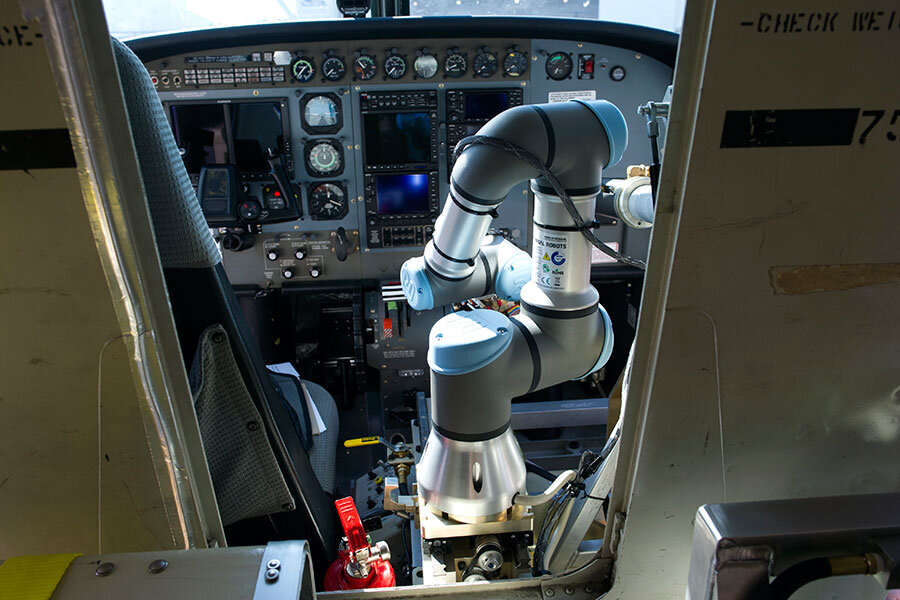Amid shortage of trained pilots, Pentagon looks to robot co-pilots
Loading...
| MANASSAS, Va.
Think of it as the airborne cousin to the self-driving car: a robot in the cockpit to help human pilots fly passengers and cargo – and eventually even replace them.
The government and industry are collaborating on a program that seeks to replace the second human pilot in two-person flight crews with a robot co-pilot that never tires, gets bored, feels stressed out, or gets distracted.
The program is funded by the Defense Advanced Research Projects Agency, the Pentagon's arm for development of emerging technologies, and run by Aurora Flight Sciences, a private contractor. With both the military and airlines struggling with shortages of trained pilots, officials say they see an advantage to reducing the number of pilots required to fly large aircraft while at the same time increasing safety and efficiency by having a robot pick up the mundane tasks of flying.
The idea is to have the robot free the human pilot, especially in emergencies and demanding situations, to think strategically.
"It's really about a spectrum of increasing autonomy and how humans and robots work together so that each can be doing the thing that it's best at," said John Langford, Aurora's chairman and chief executive officer.
Mr. Langford even envisions a day when a single pilot on the ground will control multiple airliners in the skies, and people will go about their daily travels in self-flying planes.
At a demonstration of the technology at a small airport in Manassas, Va., on Monday, a robot with spindly metal tubes and rods for arms and legs and a claw hand grasping the throttle was in the right seat of a single-engine Cessna Caravan. In the left seat, a human pilot tapped commands to his mute colleague on an electronic tablet. The robot did the flying.
Sophisticated computers flying planes aren't new. In today's airliners, the autopilot is on nearly the entire time the plane is in the air. Airline pilots do most of their flying for brief minutes during takeoffs and landings, and even those critical phases of flight could be handled by the autopilot.
This program, known as Aircrew Labor In-Cockpit Automation System, or ALIAS, goes steps further. For example, an array of cameras allows the robot to see all the cockpit instruments and read the gauges. It can recognize whether switches are in the on or off position, and can flip them to the desired position. And it learns not only from its experience flying the plane but also from the entire history of flight in that type of plane.
The ALIAS robot "can do everything a human can do" except look out the window, Langford said. Give the program time and maybe the robot can do that, too, he said.
In other ways, the robot is better than the human pilot, reacting faster and instantaneously calling up every emergency checklist for a possible situation, officials said.
In some ways, it will be like flying with a "co-pilot genius," Langford said. "The robot carries in them the DNA of every flight hour in that (aircraft) system, every accident," he said. "It's like having a human pilot with 600,000 hours of experience."
The robot is designed to be a "drop-in" technology, ready for use in any plane or helicopter, even 1950s vintage aircraft built before electronics.
But the robot faces a lot of hurdles before it's ready to start replacing human pilots, not the least of which is that it would require a massive rewrite of Federal Aviation Administration safety regulations. Even small changes to FAA regulations often take years.
Elements of the ALIAS technology could be adopted within the next five years, officials said, much the way automakers are gradually adding automated safety features that are the building blocks of self-driving technology. Dan Patt, DARPA's ALIAS program manager, said replacing human pilots with robots is still a couple of decades away, but Langford said he believes the transition will happen sooner than that.
Pilot unions are skeptical that robots can replace humans. Keith Hagy, the Air Line Pilots Association's director of engineering and safety, pointed to instances of multiple system failures during flights where only the heroic efforts of improvising pilots saved lives.
In 2010, for example, an engine on a jumbo Qantas airliner with 469 people on board blew up, firing shrapnel that damaged other critical aircraft systems and the plane's landing gear. The plane's overloaded flight management system responded with a cascading series of emergency messages for which there was no time to respond. By chance, there were five experienced pilots on board – including three captains – who, working together, were able to land the plane. But it was a close call.
"Those are the kind of abnormal situations when you really need a pilot on board with that judgment and experience and to make decisions," Mr. Hagy said. "A robot just isn't going to have that kind of capability."







